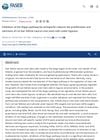Olig2 Positive Cells Derived From Hair Follicle Neural Crest Stem Cells In Rats
February 2020
in “
Journal of chemical neuroanatomy
”
TLDR Researchers found a way to make rat hair follicle cells start turning into motor neuron-like cells, but couldn't fully turn them into working motor neurons.
The study investigated the potential of hair follicle neural crest stem cells (hfNCSCs) to differentiate into Olig2 positive motor neuron progenitors (MNPs) in rats. The researchers used a combination of 5 small molecules to induce hfNCSCs, which were harvested from the bulge area of hair follicles of male Sprague-Dawley rats. The induced cells displayed characteristics of neural stem cells and showed promising viability and morphology. The findings suggested that hfNCSCs could serve as a new cell source for motor neuron disease (MND) treatment, offering a potential alternative to autologous motor neurons, which are limited by their unrenewable nature.

